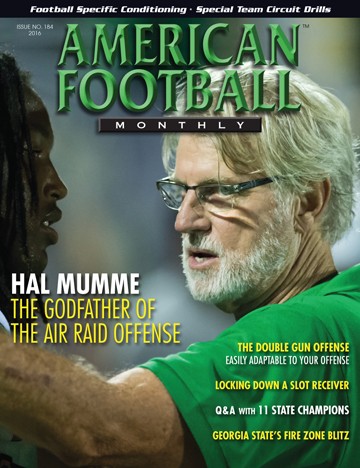Article CategoriesAFM Magazine
|
Hal Mumme – The Godfather of the Air Raid Offenseby: AFM Editorial Staff© More from this issue Considered the original architect of the Air Raid Offense, Hal Mumme developed his passing game after studying the playbook of LaVell Edwards, the near-legendary coach of BYU. Mumme first brought the offense to Texas when he was the head coach at Copperas Cove High School. Mumme studied Edwards and built the high school program into a consistent power with the strength of a wide open passing attack. In those days the I-formation was king but Mumme saw possibilities with three and four receiver sets. Later he became the head coach at Iowa Wesleyan where he first installed the Air Raid. He then had stops as head coach at Valdosta State, Kentucky, Southeastern Louisiana University, New Mexico State, McMurry University, and currently Belhaven University in Mississippi. Mumme’s offense features widely split linemen, a four or five receiver set on most downs, and plays that feature pass plays about 80% of the time. His strategy is to utilize short passes to multiple receivers and backs coming out of the backfield. By doing so, he stretches the field both vertically and horizontally. Opponents are forced to cover the entire field. One of the traditional plays of the Air Raid Offense is the mesh. It features multiple receivers on the outside with a shallow cross over the middle where two receivers run what is termed a ‘rub route’ or pick play. The WRs run five yards from the line of scrimmage. The play offers various options. A receiver on the outside runs a curve route while a running back releases into the flat. If one play defines the Air Raid, it’s the mesh. It puts players in space. Mumme feels two elements make the Air Raid different. “First is it’s simplicity, allowing players to rep a great deal and develop their skill sets,” he said. “I’ve found that it isn’t as much talent as it is perseverance and the willingness to work hard at it. The second element is our philosophy of practice and game planning is to have fun. When I first starting coaching at the high school level in Texas, we lost many players to other sports. But we made it fun for our athletes and we started to get the better athletes to play football.” In his first major hire at Iowa Wesleyan, Mumme hired a young Mike Leach as his offensive coordinator. The two coaches decided to do away with three-point stances, figuring that it would help their offensive line to get in position to pass block that much faster. They also placed the quarterback in the shotgun and decided to play as fast as they can, in many cases being a no-huddle offense. The result – Iowa Wesleyan led the nation in passing offense once and finished second twice in Mumme’s three years at the school. Mumme’s coaching tree reads like a Who’s Who in the college coaching world. Leach taught Mark Mangino, when he was the offensive coordinator at Oklahoma, the Air Raid offense and the following year the Sooners won the National Championship. Leach has used the Air Raid successfully at both Texas Tech and Washington State. In Lubbock, Leach’s teams led the nation in passing offense three consecutive years with three different QBs. Other disciples include: Mumme feels the Air Raid over the last two decades has been tweaked. “It started with Dana Holgorsen and Kevin Sumlin in Houston,” he said. “They used the run and pass option and the inside zone to make the offense a more quantified run game. More running plays are then called. Similarly, the one position that has changed over time is the quarterback position. When I was at BYU and studying under LaVell Edwards, I looked at all the great QB tapes and it was Steve Young that stood out. He had great footwork so each play is never dead. That’s the kind of new QB we have today running the Air Raid. They have incredible athleticism.” ESPN’s Kevin Van Valkenburg recently wrote a profile on Mumme. In the article, he mentioned that Nick Saban would probably be voted as the best college football coach over the last two decades. “But what about the most influential coach of the last 20 years. That’d be Hal Mumme. He wasn’t the only one to drag college football out of its ground and pound dark ages. But as Kentucky’s coach in the late 1990s, he is the one who brought video game offenses to the SEC, the game’s motherland. And it was there that football changed forever. If Cam Newton or Johnny Manziel ever did something that made you jump off your couch, you have Mumme to thank.” Mumme has developed a complete ‘system’ on the Air Raid Offense that includes lectures, DVDs, and webinars. Mumme believes the first lecture on the Air Raid System is one of the most important parts of the Air Raid System. “It includes game planning and practice schedules that are simple and easy to apply to your offense, whether you run the Air Raid or not,” he said. “It forces you to make decisions.” |
|
| HOME |
MAGAZINE |
SUBSCRIBE | ONLINE COLUMNISTS | COACHING VIDEOS |
Copyright 2024, AmericanFootballMonthly.com
All Rights Reserved




